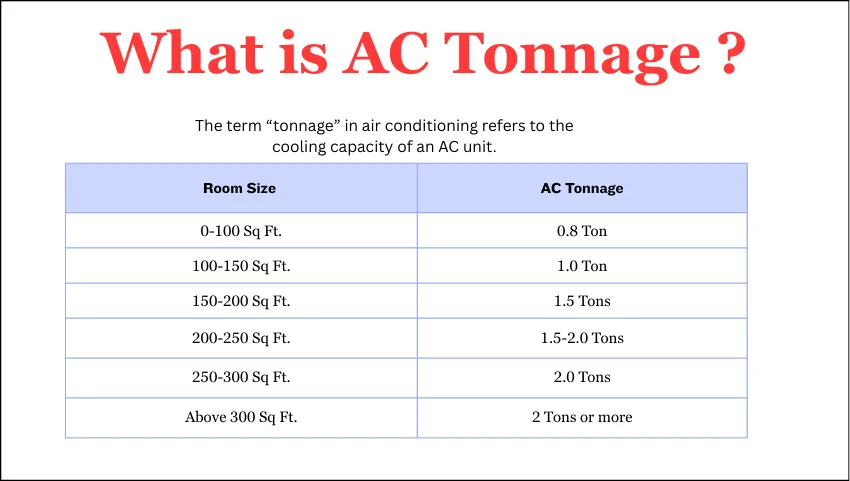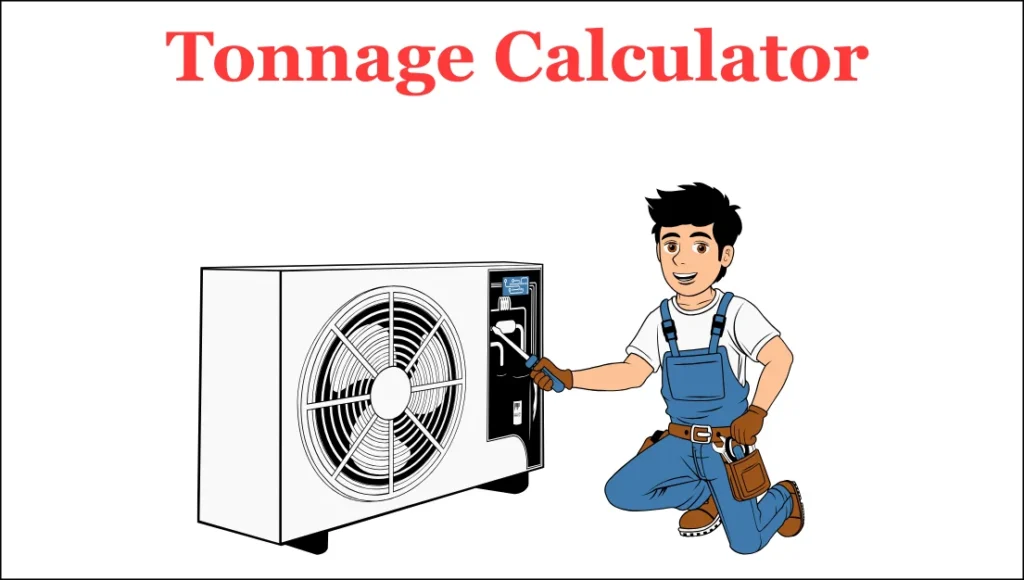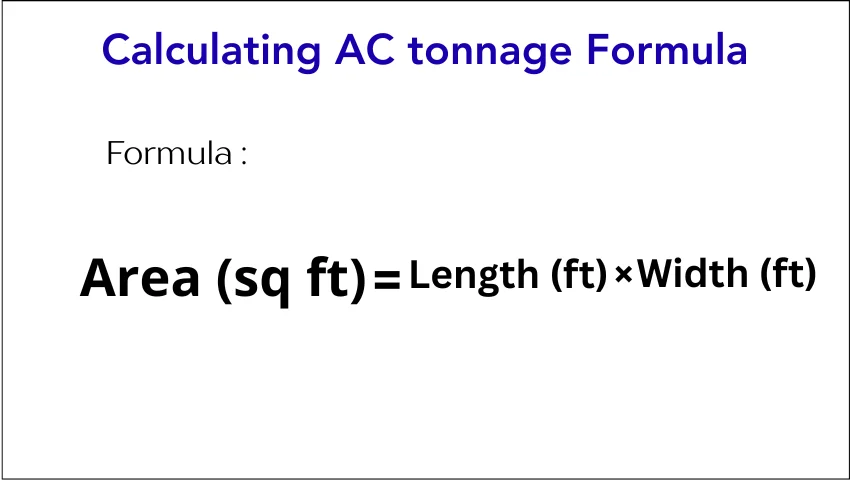AC Tonnage Calculator
Find the perfect air conditioner size for your room. Get accurate tonnage recommendations based on your room specifications and usage patterns.
How AC Tonnage Works
AC tonnage refers to the cooling capacity of an air conditioner. One ton of cooling capacity equals 12,000 BTU (British Thermal Units) per hour. This represents the amount of heat needed to melt one ton of ice in 24 hours. The right tonnage ensures optimal cooling, energy efficiency, and comfort in your space.
Air conditioners have become an essential part of our lives, especially in warm climates. But choosing the right AC size, or tonnage, for your room is crucial for comfort, energy efficiency, and cost savings. Many people either end up with an AC that is too small or too large, causing inefficient cooling, higher bills, or even quicker wear and tear. This article will help you understand what tonnage means, why it matters, and how to use a tonnage calculator to find the perfect AC size for your specific needs.
What is AC Tonnage? Understanding the Basics
The term “tonnage” in air conditioning refers to the cooling capacity of an AC unit. It is not about the physical weight of the machine, which many mistakenly believe. Instead, it tells you how much heat the AC can remove from a space per hour.

- 1 ton of AC means the unit can remove 12,000 British Thermal Units (BTUs) of heat in an hour.
- The term originated from how much heat it takes to melt 1 ton (2,000 pounds) of ice in 24 hours.
- So, a 2-ton AC can remove 24,000 BTUs per hour, suitable for larger rooms.
BTU stands for British Thermal Unit, and it’s a way to measure heat energy. To put it simply, the higher the BTU, the more cooling power an AC has. A room with more space or higher heat loads will need AC with higher tonnage.
Why Is Choosing the Right Tonnage Important?
Choosing the right air conditioner tonnage for your room can save you money, improve comfort, and increase your AC’s lifespan. Here’s why:
- Too little tonnage (undersized AC): The AC runs continuously to cool the space but never fully achieves the desired temperature. This increases wear and tear and energy bills.
- Too much tonnage (oversized AC): The AC cools quickly but doesn’t remove enough humidity, leaving the room cold and damp. It also wastes energy by frequently turning on and off.
- Right tonnage: The AC cools efficiently, maintains comfort, controls humidity, consumes less power, and lasts longer.
In short, the perfect AC tonnage keeps your room comfortably cool and energy-efficient.
Factors Affecting AC Tonnage Calculation
The size of your room alone is not the only factor to consider for AC tonnage. Several other aspects affect the cooling load, including:

- Room dimensions: length, width, and ceiling height.
- Room usage: Number of people regularly occupying the space.
- Sunlight exposure: Rooms with many windows or large windows with direct sunlight need higher cooling capacity.
- Appliances and electronics: Heat generated from devices and kitchen appliances adds to the cooling load.
- Insulation: Well-insulated rooms retain cool air better and need less tonnage.
- Climate: Hotter regions may require 10-20% more cooling capacity.
A tonnage calculator considers many of these inputs to give you an accurate recommendation.
How to Calculate AC Tonnage Using a Tonnage Calculator
To get an accurate tonnage recommendation, you can use a tonnage calculator designed for air conditioners. Here’s a simple step-by-step guide for calculating AC tonnage manually or by using an online tool:

Step 1: Measure the Room Size
Calculate the area of your room (in square feet) by multiplying length x width.Area (sq ft)=Length (ft)×Width (ft)
For example, if your room is 15 feet long and 12 feet wide:15×12=180 sq ft
Step 2: Consider Ceiling Height
Most calculations assume an 8-foot ceiling. If your ceiling is higher, multiply the area by: Ceiling height/8
For instance, if your ceiling is 10 feet high: 180×810=225 adjusted sq ft
Step 3: Calculate Base Cooling Capacity in BTUs
A general rule of thumb is 20 BTUs per square foot of space. Base BTU=Adjusted Area×20
Using the previous example: 225×20=4500 BTUs
Step 4: Adjust for Additional Factors
- Add 600 BTUs per additional person beyond two.
- Add 10-20% BTUs for sun-exposed rooms or hot climates.
- Add 4000 BTUs if it’s a kitchen due to appliances.
- Add 10% BTUs for each window receiving strong sunlight.
Step 5: Convert BTUs to Tonnage
Divide the total BTUs by 12,000 to get the tonnage needed: Tonnage=12,000 Total BTU
For example, if the total BTU is 12,000:12,000/12,000=1 Ton
Example of AC Tonnage Calculation
Let’s say you have a living room with the following specs:
- Length: 20 ft
- Width: 15 ft
- Ceiling Height: 9 ft
- People: 4 (2 extra beyond standard 2)
- Sunlight exposure: High (south-facing windows)
Calculate adjusted area: area: 20×15=300 sq ft; 300×89=337.5 sq ft
Base BTU: 337.5×20=6750 BTUs
Add for extra people: 2×600=1200 BTUs
Add for sunlight (10% of base): 6750×0.10=675 BTUs
Total BTU: 6750+1200+675=8625 BTUs
Calculate tonnage: 12,000,8625 = 0.71875 tons
So, a 0.75-ton AC would be a good choice for this room.
Two Popular Methods for Quick AC Tonnage Estimation
If you prefer quick math without multiple factors, here are two easy methods used widely:
1. Area Method (Square Footage)
- Measure the length and width.
- Multiply to get area.
- Divide the square root of the area by 10.
Example:
Room size = 15 ft x 20 ft = 300 sq ft
The square root of 300 is 17.32.
Divide by 17.32/10 = 1.73 tons
2. Volume Method (Cubic Feet)
- Multiply length, width, and height.
- Divide by 1000.
Example:
Room size = 15 ft x 20 ft x 10 ft = 3000 cubic feet
Divide by 1000: 3000/1000=3 tons
This method assumes more ventilation or heat load and is ideal for rooms with high ceilings.
How to Use an Online AC Tonnage Calculator
Online calculators make it very easy to get accurate tonnage recommendations with minimal math. Most tonnage calculators require:
- Room length, width, and height (optional)
- Number of occupants
- Type of room (bedroom, kitchen, living room)
- Sunshine exposure or window count
- External door count (some calculators ask this)
Once you enter data, the calculator will:
- Estimate the needed BTUs
- Convert BTUs into tons (1 ton = 12,000 BTUs)
- Recommend the appropriate AC tonnage
Some reliable online calculators:
- Carrier Midea India Tonnage Calculator
- Mitsubishi Electric Tonnage Calculator
- Omni Calculator AC Tonnage Calculator
These tools use industry-standard methods like Manual J calculation for precise results.
Tips to Choose the Right AC Size for Your Room
- Always measure your room dimensions carefully.
- Consider daily usage and number of people.
- Think about sunlight exposure and insulation.
- When in doubt, consult an AC professional or use an online tonnage calculator.
- Do not buy an AC just based on room size alone.
- Keep some margin for appliances and warmer weather.
Common Issues with Wrong AC Size
- Undersized AC: Runs constantly, high electricity bills, poor cooling.
- Oversized AC: Short cycling, moisture buildup, discomfort, and high upfront cost.
- Both lead to increased repair costs over time.
Why Use a Tonnage Calculator Instead of Guesswork?
Using a tonnage calculator helps you avoid costly mistakes by considering factors that simple formulas miss. It accounts for:
- Ceiling height
- Occupancy load
- Sunlight and window exposure
- Room type and appliances
This ensures you get an energy-efficient AC that keeps your home comfortable year-round.
Frequently Asked Questions
What is AC tonnage?
AC tonnage refers to the cooling capacity of an air conditioner. One ton equals the ability to cool 12,000 BTUs (British Thermal Units) per hour.
Why is choosing the right AC tonnage important?
Choosing the correct tonnage ensures your AC cools the room efficiently without wasting energy or causing discomfort from over- or under-cooling.
How do I calculate the AC tonnage for my room?
You can calculate AC tonnage by measuring your room size (length × width) and then using the formula Total BTUs = Area (sq. ft) × 20. Divide BTUs by 12,000 for tonnage.
Can I use an AC tonnage calculator online?
Yes, online tonnage calculators help you accurately estimate the ideal AC size by considering room size, ceiling height, occupancy, and sunlight exposure.
What happens if my AC tonnage is too small?
If the AC is too small, it will run continuously but fail to cool the room adequately, leading to higher electricity bills and system strain.
Is it better to buy a slightly larger or smaller AC unit?
It’s best to buy a unit that closely matches your calculated tonnage. Avoid buying too large or too small; rather, choose the nearest standard size slightly above your needs.
Conclusion
Whether installing a new air conditioner or replacing an old one, finding the right tonnage is vital for comfort, efficiency, and savings. By understanding how AC tonnage works, considering your room’s unique features, and using a reliable tonnage calculator, you can select the perfect AC size for your space. Remember, the right tonnage cools your room effectively without wasting energy or money. Using the easy steps and calculators shared here will help make your cooling choices smart and confident.
